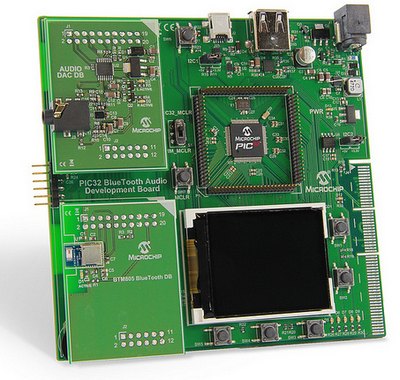Microchip PIC32 Bluetooth Audio Development Kit (DV320032)
The PIC32 Bluetooth Audio Development Kit provides a comprehensive solution to develop Bluetooth A2DP audio streaming solutions and applications.
Detailed Description
The board is coupled with two daughter cards: the Bluetooth HCI Radio Daughter Card that demonstrates a low cost Bluetooth implementation and the Audio DAC Daughter Card that demonstrates a high quality 16/24-bit, 32-192 KHz audio conversion/amplification for line or headphones. The kit ships with demo code that enables wireless streaming digital audio from any Bluetooth enabled Smartphone or portable music player or over USB.

The PIC32 Bluetooth Audio Development Kit that ships with audio streaming demo code delivers up to 24-bit, 192 kHz audio and has been tested with over 100 different Bluetooth audio enabled devices, spanning 18 different manufacturers. The Bluetooth Hardware module and the Bluetooth A2DP audio software have been Bluetooth.org certified, saving the developer significant certification costs. The modular design allows developers to swap out the included daughter boards (one for Audio and one for Bluetooth), to create their own custom versions with their preferred audio and wireless solution. The kit also supports USB Host and Device connectivity, Apple® device authentication module interface, a 2-inch color LCD, five general-purpose button switches, 5 LEDs and a Plug-In-Module interface for PIC32 microcontroller upgrades. The PIC32MX450F256 MCU is included which runs at 80 MHz with 256 KB Flash and 64 KB RAM. With such a broad feature-set and flexibility, the kit makes an excellent general purpose development tool.
The PIC32 Bluetooth Audio Development Kit has the following features:
- PIC32MX450F256L or PIC32MX470F512L 32-bit microcontroller.
- Hardware selection of PIM or board mounted microcontroller.
- 6.9V to 14V DC power input (provides +3.3V and +5V (regulated) to kit hardware.
- Overvoltage protection circuit (14.4V trip) and fused overcurrent protection.
- Power indicator LED.
- USB Type-A connector to support USB audio and MP3.
- USB 3:1 multiplexer (for connecting the PIC32 device to a Type-A, mini-B, or off-board USB source).
- USB charge management IC (auto-negotiating USB quick charge current up to 2.5 amps and support for simultaneous audio and charging).
- 2" 176 x 220 RGB graphics TFT display.
- Device Reset push button.
- Six user-definable push buttons.
- Potentiometer for master volume control (i.e., not synchronized with audio device volume control).
- Five user application indicator LEDs.
- I2C pull-up headers (selectable to either 3.3V or 5V).
- 2 Mb SPI serial EEPROM.
- PICtail Plus connector with support for an external USB Apple authentication adapter.
- PICkit 3 In-Circuit Debugger/Programmer connector.
- 16-bit/24-bit Stereo DAC and 70 mW line-out/headphone connector.
- Certified HCI Class 1 Bluetooth radio module.
- PIC32 Bluetooth Audio Development Board (DM320032).
- 24-bit Audio DAC/AMP Daughter Board (AC320032-2).
- Bluetooth HCI Radio Module Daughter Board (AC320032-1).
Key Features:
- PIC32MX450/470 MCU
- HCI Bluetooth module Daughter Card (QDID Certified Module)
- 16/24-bit, 32-192KHz DAC/Amp Daughter Card
- USB Host/Device audio support
- USB Charging
- 2 inch color LCD Display
- Headphone/Line Out
- Audio Control function
Bluetooth /USB Audio Software Support for:
- Apple
- Samsung Audio
- Google/Android AOA Audio
- Bluetooth Audio w/ SBC & AAC Decode
- Bluetooth Stack QDID Certified
The PIC32 Bluetooth Audio Development Kit (P/N: DV320032) contains the following items:
- PIC32 Bluetooth Audio Development Board (P/N: DM320032)
- Bluetooth HCI Radio Module Daughter Board (P/N: AC320032-1)
- 24-bit stereo DAC Line-out/Headphone Amplifier Daughter Board (P/N: AC320032-2)
- On-board preprogrammed PIC32MX450F256L or PIC32MX470F512L
